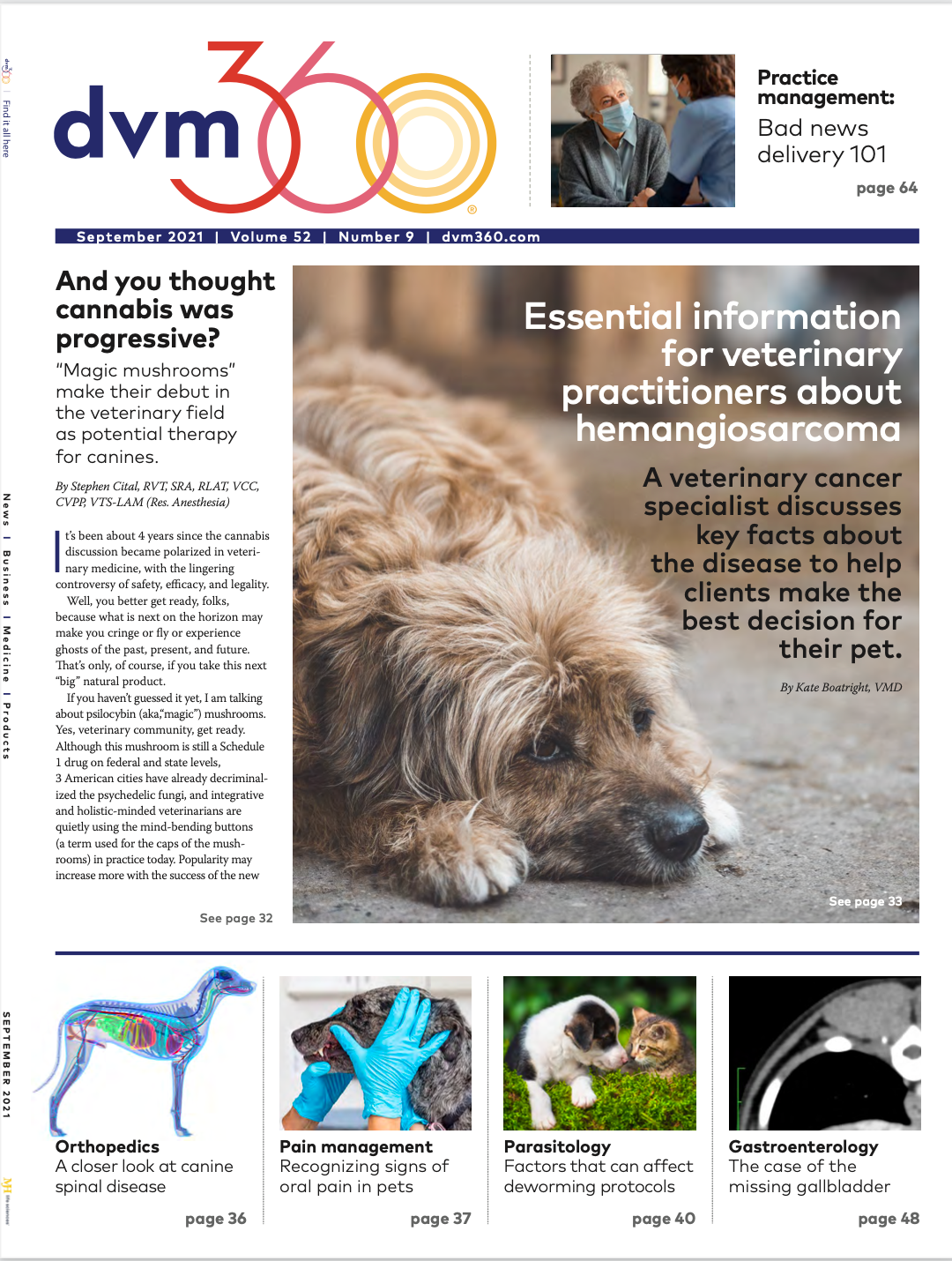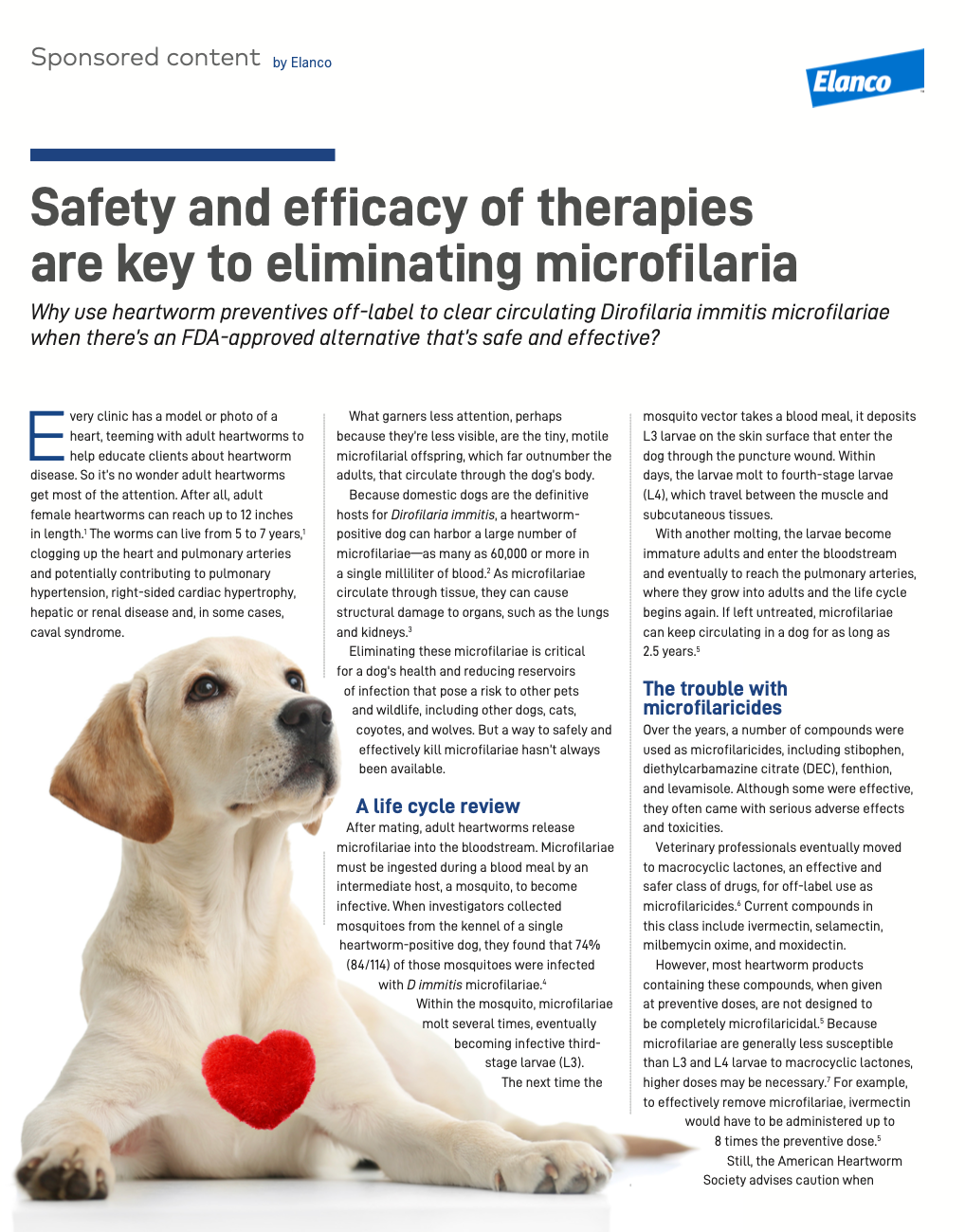Safety and efficacy of therapies are key to eliminating microfilaria
Why use heartworm preventives off-label to clear circulating Dirofilaria immitis microfilariae when there’s an FDA-approved alternative that’s safe and effective? (Sponsored by Elanco).
Every clinic has a model or photo of a heart, teeming with adult heartworms to help educate clients about heartworm disease. So it’s no wonder adult heartworms get most of the attention. After all, adult female heartworms can reach up to 12 inches in length.1 The worms can live from 5 to 7 years,1 clogging up the heart and pulmonary arteries and potentially contributing to pulmonary hypertension, right-sided cardiac hypertrophy, hepatic or renal disease and, in some cases, caval syndrome.
What garners less attention, perhaps because they’re less visible, are the tiny, motile microfilarial offspring, which far outnumber the adults, that circulate through the dog’s body.
Because domestic dogs are the definitive hosts for Dirofilaria immitis, a heartworm-positive dog can harbor a large number of microfilariae—as many as 60,000 or more in a single milliliter of blood.2 As microfilariae circulate through tissue, they can cause structural damage to organs, such as the lungs and kidneys.3
Eliminating these microfilariae is critical for a dog's health and reducing reservoirs of infection that pose a risk to other pets and wildlife, including other dogs, cats, coyotes, and wolves. But a way to safely and effectively kill microfilariae hasn’t always been available.
A life cycle review
After mating, adult heartworms release microfilariae into the bloodstream. Microfilariae must be ingested during a blood meal by an intermediate host, a mosquito, to become infective. When investigators collected mosquitoes from the kennel of a single heartworm-positive dog, they found that 74% (84/114) of those mosquitoes were infected with D immitis microfilariae.4
Within the mosquito, microfilariae molt several times, eventually becoming infective third-stage larvae (L3). The next time the mosquito vector takes a blood meal, it deposits L3 larvae on the skin surface that enter the dog through the puncture wound. Within days, the larvae molt to fourth-stage larvae (L4), which travel between the muscle and subcutaneous tissues.
With another molting, the larvae become immature adults and enter the bloodstream and eventually to reach the pulmonary arteries, where they grow into adults and the life cycle begins again. If left untreated, microfilariae can keep circulating in a dog for as long as 2.5 years.5
The trouble with microfilaricides
Over the years, a number of compounds were used as microfilaricides, including stibophen, diethylcarbamazine citrate (DEC), fenthion, and levamisole. Although some were effective, they often came with serious adverse effects and toxicities.
Veterinary professionals eventually moved to macrocyclic lactones, an effective and safer class of drugs, for off-label use as microfilaricides.6 Current compounds in this class include ivermectin, selamectin, milbemycin oxime, and moxidectin.
However, most heartworm products containing these compounds, when given at preventive doses, are not designed to be completely microfilaricidal.5 Because microfilariae are generally less susceptible than L3 and L4 larvae to macrocyclic lactones, higher doses may be necessary.7 For example, to effectively remove microfilariae, ivermectin would have to be administered up to 8 times the preventive dose.5
Still, the American Heartworm Society advises caution when administering macrocyclic lactones to dogs with high microfilariae counts due to the potential for anaphylactic reactions associated with rapid kills. As more people travel with their dogs, and homeless dogs are increasingly transported to other locations for adoption, safe and effective macrocyclic lactones are crucial to help reduce the spread of D. immitis from microfilarial dogs.
Transdermal moxidectin is labeled as a microfilaricide
Tansdermal Advantage Multi® (imidacloprid + moxidectin) for Dogs is a heartworm prevention approved by the US Food and Drug Administration (FDA) to kill circulating microfilariae in heartworm-positive dogs. This approval was based on studies with experimentally and naturally infected heartworm-positive dogs that focused not only on efficacy but safety too.
In a controlled laboratory study, adult heartworms were surgically implanted in 20 dogs 82 days before product application.6 Participating dogs were required to have at least 300 microfilariae per milliliter of blood. On study days 0 and 28, Advantage Multi was applied to 10 dogs, and an equivalent volume of mineral oil was administered to 10 control dogs. Blood samples were drawn for microfilarial counts on the first 3 days, then weekly through day 28, and once more on day 42. Mean microfilarial counts for the treated dogs were reduced by more than 99.7% on days 14 through 42. No treatment related adverse events were noted.
Another study evaluated the effects of Advantage Multi on dogs that were naturally infected with D immitis.8 To qualify, the 22 heartworm-positive dogs were required to have at least 300 microfilariae per milliliter of blood. Like the previous study, half the dogs were treated with Advantage Multi on study days 0 and 28, and the control dogs were treated with mineral oil. Blood draws for microfilarial counts were performed based on a similar schedule. In this case, the results were similar to the previous study: On days 14 through 42, microfilarial counts were reduced by more than 99.9% in treated dogs. No treatment related adverse events were observed.
Finally, a multicenter field study evaluated 181 client-owned, heartworm-positive dogs that had circulating microfilariae.9 Dogs were split into 2 groups. All dogs were treated with Advantage Multi on study days 0 and 28; however half the dogs were also treated with melarsomine on days –14, 14, and 15. After microfilarial counts were performed on days 28 and 42, the group that received Advantage Multi and melarsomine experienced a reduction in microfilaria of 99.6% and 99.7%, respectively. The group treated with Advantage Multi demonstrated similar success with reductions of reductions of 98.8% and 99.2%, respectively. Advantage Multi was well tolerated when administered to heartworm-positive dogs alone or in combination with melarsomine.
Treat microfilariae early
Currently, the American Heartworm Society recommends treating heartworm-positive dogs with a macrocyclic lactone and doxycycline at the time of diagnosis.
As a product with an FDA-approved indication to treat circulating microfilariae in heartworm- positive dogs, Advantage Multi can be a useful part of any clinic arsenal, especially in heartworm endemic regions of the country.
The transdermal formulation is designed to safely deliver the highest approved dose of moxidectin (2.5 mg/kg) on the market. When applied, moxidectin is quickly absorbed through the skin and enters the bloodstream. It concentrates in the fat and tissues and remains active all month long. Advantage Multi kills adult fleas, treats flea infestations, treats and controls sarcoptic mange and intestinal parasite infections, and of course prevents heartworm disease and treats circulating microfilariae.
References
- Heartworm disease in dogs. American Heartworm Society. Available at: www.heartwormsociety.org/images/pdf/AHS_dog_brochure-Final1.pdf.
- Nguyen C, Koh WL, Casteriano A, et al. Mosquito-borne heartworm Dirofilaria immitis in dogs from Australia. Parasit Vectors. 2016;9(1):535. doi:10.1186/s13071-016-1821-x
- Ames, Marisa. A selective summary of the 2019 Triennial Heartworm Symposium. Accessed February 1, 2021. https:// todaysveterinarypractice.com/a-selective-summary-of-the-2019- triennial-heartworm-symposium/.
- McKay T, Bianco T, Rhodes L, Barnett S. Prevalence of Dirofilaria immitis (Nematoda: Filarioidea) in mosquitoes from northeast Arkansas, the United States. J Med Entomol. 2013;50(4):871-878. doi:10.1603/me12197
- Bowman DD, Atkins CE. Heartworm biology, treatment and control. Vet Clin North Am Small Anim Pract. 2009;39(6):1127-1158. doi:10.1016/j.cvsm.2009.06.003.
- McCall JW, Arther R, Davis W, Seetje T. Safety and efficacy of 10% imidacloprid+2.5% moxidectin for the treatment of Dirofilaria immitis circulating microfilaria in experimentally infected dogs. Vet Parasitol. 2014;206 (1-2):86-92. doi:10.1016/j.vetpar.2014.09.011
- Bowman D, Mannella C (2011). Macrocyclic lactones and Dirofilaria immitis microfilariae. Top Companion Anim Med. 2011;26(4):160-172.
- Bowman DD, Charles SD, Arther RG, Settje T. Laboratory evaluation of the efficacy of 10 % imidacloprid + 2.5 % moxidectin topical solution (Advantage® Multi, Advocate®) for the treatment of Dirofilaria immitis circulating microfilariae in dogs. Parasitol Res. 2015;114(Suppl 1):S165-174. doi:10.1007/s00436-015-4522-z
- Elanco. Data on file. Freedom of information Summary Supplement, NADA: 141-251.

